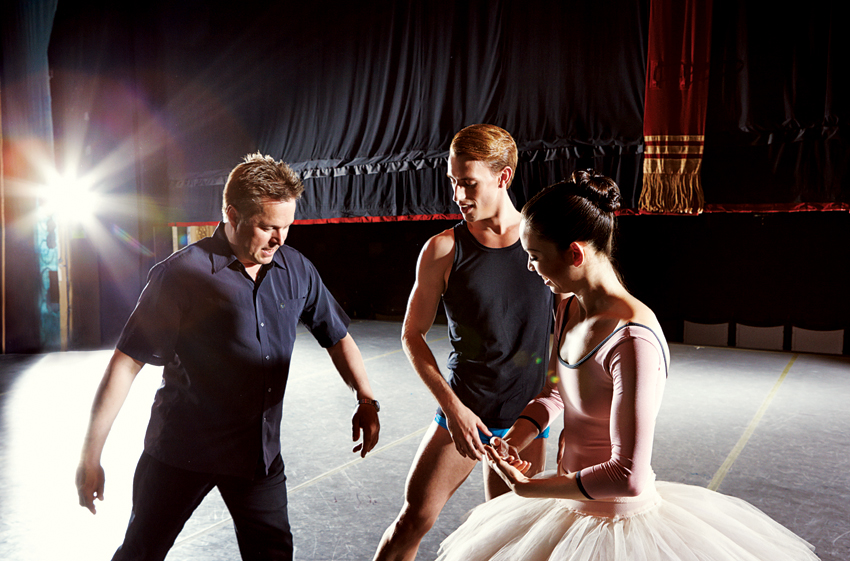What’s Next for Boston Ballet Director Mikko Nissinen?

Photographs by Finlay Mackay
Backstage at the Boston Opera House, five minutes before the curtains were to rise on a Friday in May, Mikko Nissinen, dressed in an all-black suit, emerged to check on his dancers. This was a rare pre-performance sighting of the artistic director of the Boston Ballet. On many nights, just before the show begins, Nissinen will sneak into a box, or the orchestra, or the back of the balcony, unbeknownst to the performers. The company, which is celebrating its half-century birthday this year, had premiered its new production, Chroma, a week earlier. Each performance since had provoked standing ovations that sounded more like what you’d expect at a Bruins game than a ballet. Nonetheless, Nissinen’s dancers knew better than to be satisfied with their early success. So even as the patrons on the other side of the curtain were asked to silence their cell phones, the dancers John Lam and Isaac Akiba were reviewing video from the previous night’s performance—the moment when they drag Jeffrey Cirio across the stage in skin-tone, crotch-length nightgowns.
Now two minutes to curtain, Nissinen, his face bathed in electric-blue batten lighting, approached 17 ballerinas dressed in diaphanous azure tulle skirts for the evening’s opening piece, the Balanchine classic Serenade. He said something that made them laugh, and then walked to his seat to witness his work.
This was one of the last performances before the Boston Ballet embarked on its ambitious 50th-anniversary season. The company would go on to perform at the London Coliseum with the Royal Philharmonic in July, and then return to stage the annual Night of Stars, which this year was presented for free on the Common in September. The season itself, which kicks off in earnest this month, includes American and world premieres in Boston, and also performances at Washington’s Kennedy Center and at Lincoln Center’s Koch Theater, in New York, next summer.
When Nissinen, who is 51, took over the company in 2001, a schedule of this magnitude seemed unimaginable. Amid fumbled searches for a director, the Boston Ballet had turned to gaudy and ill-choreographed story ballets, and other than a single performance in New York, hadn’t performed outside Massachusetts in a decade. And little wonder. The Globe concluded that the 1999 season’s repertory “was so dismal you wonder why any presenter would want to import the Boston troupe.” Along the way, the company lost talent, clout, and its home for three decades—the Wang Theatre—and fell $8 million into debt. And after a dancer’s death, it was beset with scandal. Yet today the company stands as the fourth-largest ballet in the country—free of long-term debt, with 58 dancers and a $31 million annual budget. In the past six years it has toured 16 cities and five countries and staged 13 world premieres. In returning the Boston Ballet to health, Nissinen, with his modernist yet populist vision, has helped undo Boston’s long-standing reputation as a conservative arts town. Nissinen and the international talent he has recruited have begun to create what all the world’s ballet companies are desperately after today: an identity.
The Boston Ballet was born in 1963, the product of a grant from the Ford Foundation. From the beginning, the company struggled to establish itself. The Melrose native E. Virginia Williams was named the company’s founding artistic director, and held the position until 1983. Williams cultivated a modest range of classics and Balanchine neoclassics—although Balanchine, an occasional artistic adviser, often poached Williams’s best dancers for his ballet in New York.
Violette Verdy, the Boston Ballet’s second director, was hired from France as codirector in 1980, became head director in 1983, and promptly quit in 1984. On her way out, she lambasted the board of trustees, telling the Globe that its members had their “own little, local, parochial, cozy plans…. They do not come to the studio or rehearsals. They do not care about dance.” Next up was Bruce Marks, who began his tenure in 1985 with a press conference in which he laid out his goal of “taking the underdog company of all time, the faceless Boston Ballet, and giving it a face.” Marks expanded the repertoire, commissioning contemporary works by the likes of Twyla Tharp and Mark Morris, and in 1991 the company opened a Graham Gund–designed, 60,000-square-foot, seven-studio, $7.5 million headquarters on Clarendon Street in the South End.

Marks left in 1997, and almost immediately afterward the company tumbled to its artistic nadir. During the three-year tenure of Anna-Marie Holmes, Marks’s successor, the company staged some of the most universally panned performances in its history. “You go away feeling you’ve seen a lot—just not a lot of dancing,” the Globe wrote of Holmes’s An American in Paris. Another review concluded that “the ballet is trying hard to sell tickets through works with high name recognition, no matter how crude the choreography.” A letter to the editor scolded a critic whose review was titled “A Lifeless Dracula” for being “too kind.” At one point, the prominent choreographer Mark Morris withdrew one of his ballets mid-production, claiming that Boston’s dancers weren’t up to his standards.
Then, in June 1997, an internal tragedy nearly sank the company. Corps de ballet dancer Heidi Guenther, who suffered from an eating disorder, suddenly died. When the media learned that Holmes had previously requested that Guenther lose five pounds, publications as varied as People and the New York Times ran headlines similar to the one in the Phoenix: “Was Boston Ballet Responsible for the Death of Heidi Guenther?” An autopsy ultimately determined that Guenther had most likely died of a genetic heart condition, but the stigma lingered, and Holmes ultimately left the ballet in 2000.
Maina Gielgud, the veteran director of the Australian Ballet, replaced Holmes, only to resign just five months later—before even setting up her office. Gielgud cited disputes with the administration, which she said had never presented her with a final budget. The company spent the next year trudging through an international search before at last landing on Mikko Nissinen, then a young artistic director who had grown up in Finland and made his reputation as a principal dancer at the San Francisco Ballet.
I met Nissinen recently in the Back Bay at one of his favorite sushi restaurants. He was wearing his usual all-black ensemble, and after a long week of late nights at the South End headquarters—budget planning, performance reviews, and rehearsals for an expansive repertoire in London—he looked sluggish. He said he was going to take a homeopathic medicine after dinner to fend off a cold. Then he asked the waitress to bring out three courses of the chef’s choice. “The more adventurous, the better,” he told her.
The more adventurous, the better: as precise a dictum as any for Nissinen’s ballet. Recent scenes from the Boston Ballet include a pianist plinking a horror score on a baby grand with 9-foot-tall legs as a dancer pirouettes beneath; orangutan-esque arm-swinging by performers in front of a white sign reading, simply, “The”; dancers crawling on bubble wrap; choreography set to the Rolling Stones, an orchestral remolding of the White Stripes, and the barking of a demonic dog; pas de deux beginning in the fetal position on the stage floor, suggesting oral sex; a pair of nude mannequins in transparent caskets hanging from the stage’s ceiling; and, notoriously, topless ballerinas. I asked if any of these were merely attention-seeking stunts. “I would never stage a gimmick,” he said, a ring of poached octopus clutched in his chopsticks. “I only select what I feel is art.”

Artistic director Mikko Nissinen adjusts his dancers’ form.


